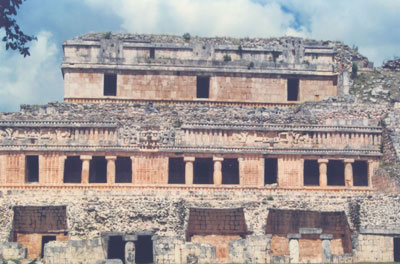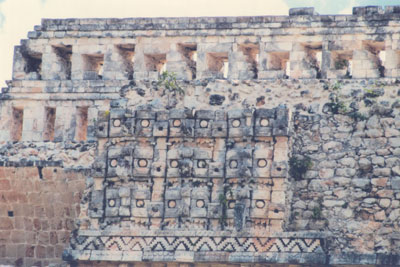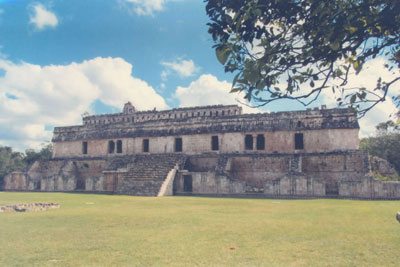Mexico’s ancient Mayan Puuc cities
This item appears on page 61 of the July 2014 issue.
South of Mérida in Mexico’s Yucatán Peninsula lies an area of limestone hills and valleys. It’s called the Puuc region, taking its name, appropriately, from the Maya word for “hill.”
It was there that one of the greatest of the Puuc Mayan cities, Uxmal, evolved, reaching its apogee between AD 600 to 900. Uxmal is now a UNESCO World Heritage Site. Thousands visit to explore the extensive ruins, especially the Pyramid of the Magician, the Governor’s Palace and the Nuns’ Quadrangle.
But close by lie three other Puuc cities, all within a few miles of each other, that most visitors to Uxmal never see or even know about: Kabah, Labná and Sayil. These sites also date from approximately AD 600 to 900.
Puuc culture’s dominance of the northern Yucatán was relatively brief. Sites centered on ceremonial centers with plazas and monumental temples developed around AD 600. Within 200 years, Puuc was dominant. The civic and religious structures erected had a distinctive style: stone facades embellished with mosaics and friezes and the prolific depiction of Chac, the Mayan rain god. Sacbeob, or elevated causeways, linked many of the Puuc cities to each other.
Then, one by one, after about AD 900, the sites were abandoned, with only sporadic periods of occupation afterward until they were eventually swallowed up by the forest.
Whether it was lack of water, shortage of food, overpopulation, disease, warfare or some combination of these, the Puuc cities disappeared until “discovered” by later explorers and archaeologists. Among them was the famous writer/artist team of John Lloyd Stephens and Frederick Catherwood, who explored Mayan ruins in the 1830s and ’40s and whose writings and engravings resulted in “Incidents of Travel in Central America, Chiapas, and Yucatán” (1841) and in “Incidents of Travel in Yucatán” (1843).
Kabah
Uxmal is located 50 miles south of Mérida. Kabah is 14 miles farther southeast. The first building one sees on entering the Kabah archaeological zone is the palace atop an artificial platform with a large forecourt in front. It’s an elegant, 2-level building with a central stairway, nine doorways on its second level, embedded columns imitating in stone the reed walls of Mayan huts and a decorative roof comb. It may once have housed Kabah’s ruling family.
Besides it is Kabah’s most famous building, Codz Poop (meaning “coiled mat” in Maya). Also called the Palace of the Masks, this 150-foot-long building, also atop a terrace, is chock-full of masks of Chac, the long-nosed god of rain, that cover its façade. Even with most of their snouts broken off, these masks are impressive. In front of the Codz Poop is a low platform lined with reliefs of Mayan glyphs.
A 15-minute walk from the palace and the Codz Poop is a monumental arch. In simple early Puuc style, this arch served as a ceremonial entry into Kabah. From the arch, a sacbe, an elevated paved limestone road, led to Uxmal, the preeminent Puuc city of the period in this region.
Labná
Ten miles southeast of Kabah is Labná, with a palace that is one of the largest in the Puuc region. Consisting of two stories with a multitude of rooms (it is estimated that there are more than 70), patios and chultunes, or water cisterns, this palace is more elaborately decorated than Kabah’s palace.
Besides some enormous Chac masks, there’s an intriguing sculpture on the corner of one building depicting a human face emerging from the jaws of a serpent. This palace probably served both as living quarters for Labná’s rulers and as an administrative center.
From the palace, visitors can walk on top of an elevated sacbe to Labná’s highlight, its corbeled arch. It’s spectacular, with deeply incised geometric patterns on one side and an elaborate composition of stone Mayan huts and geometric designs on the other. Although called an arch, it may actually have been a passageway between two courtyards, with buildings attached to either side of the passage.
Overlooking the Labná arch is the rubble of what was once an enormous pyramid called El Mirador. Atop the stone pile sit the picturesque ruins of a small temple with a high roof comb.
Sayil
Sayil is five miles west of Labná (I did a bit of backtracking since I wanted to leave Sayil for last). Sayil’s most famous building is its Grand Palace, which is — true to its name — very grand, indeed.
There are three tiers, with the roof of each level serving as a patio for the floor above. A wide central staircase connects the levels. The façade is decorated with stone panels; images of the Mayan figure known as the “descending god” (looking like a diver taking the plunge); Chac masks with long curled noses, and paired columns creating porticoes for interior rooms.
Sayil’s palace, like Labná’s, probably served as both an administrative center and as a residence for the elite.
Buried nearby under shrubs and vines are Sayil’s many other buildings: a mirador similar to Labná’s, a ball court, other palaces, temples and small mounds that once supported reed huts.
It is possible to visit all three archaeological sites on a day trip from Mérida with either a rental car or with a car and driver. I would not suggest including Uxmal with these three if doing a day excursion. It’s too much to fit into one day comfortably.
My husband and I spent two nights at Uxmal at the excellent The Lodge at Uxmal, five minutes from the entrance to the archaeological site. Then, before returning to Mérida on the third day, we visited Kabah, Labná and Sayil, spending about an hour at each site.
Each of the three sites is open daily from 8 to 5 and charges an admission of 43 pesos, about $3.30 at the time of our visits.
If you go…
We spent a month in Mérida, from mid-January to mid-February 2014, and loved it. There are not only lovely, lively plazas but excellent museums, including the new Gran Museo del Mundo Maya, and an abundance of first-rate restaurants serving traditional Yucatecan cuisine.
Best was that Mérida offers free Yucatecan dance or music performances in a different open-air venue almost every night of the week.
We rented an elegant home, Los 5 Robles (Calle 68, No. 493, Mérida), about a 15-minute walk from Mérida’s main plaza. Beautifully furnished, the home came with four bedrooms, five bathrooms, a large balcony, two terraces (one of them a huge roof terrace with views) and a plant-filled garden-patio with a small pool and a fountain.
The cost was $5,500 for the month — reasonable at about $183 per night, I thought, for a house I rated A+.
Contact Mexico International (Calle 58A, No. 476 [y 25 y 25A], Dept. 3, Colonia Itzimna, Yucatán, México; phone 52 999 926 3926, email leann@mexintl.com or visit www.mexintl.com and, in the box labeled “Enter Property Code,” type “3496”).
To see some Frederick Catherwood lithographs of Mayan archaeological sites, visit Casa Catherwood (Calle 59, No. 572), a small museum. It’s open Monday to Saturday from 9 to 2 and 5 to 9. There’s a small café on site in the patio.




